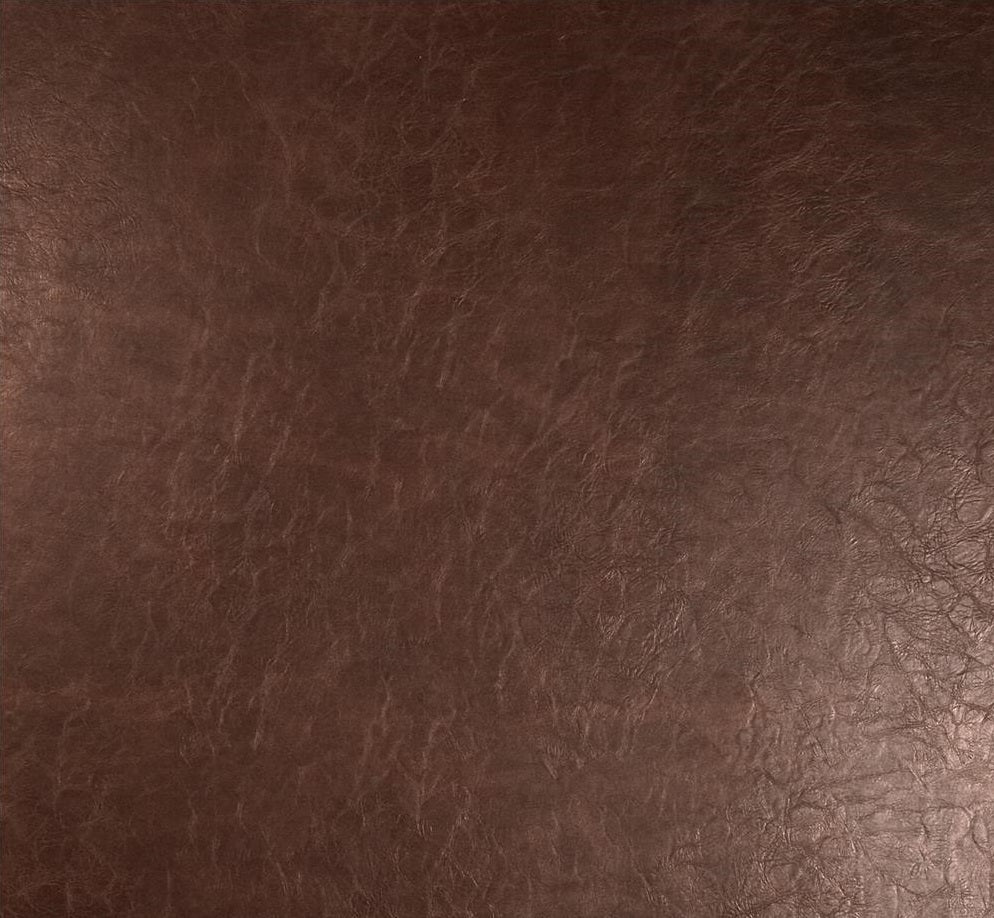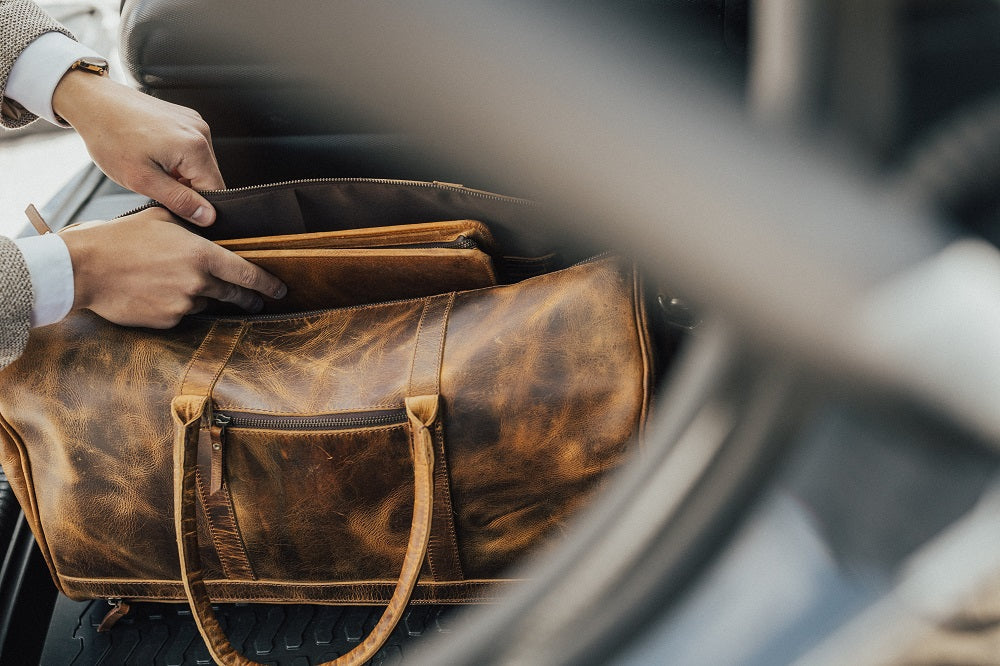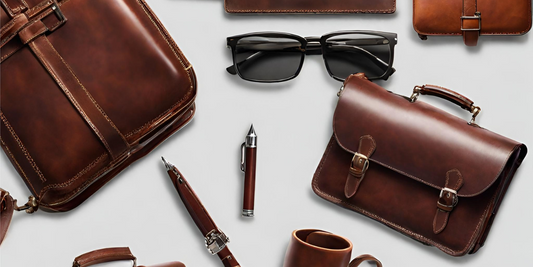You might have heard of the term faux leather.
Or maybe one of its pseudonyms – synthetic leather, fake leather, leatherette, or pleather.
But what exactly is faux leather?
This is a comprehensive guide that contains all the information you need to know about faux leather.
So, without further ado, let’s get right to it.
What is Faux Leather?
Faux leather is a manufactured, fake alternative to natural, genuine leather.
Faux leather attempts to mimic the look and feel of real leather. It's a durable, tough, and affordable material. However, it is not considered as durable or insulating as genuine leather.

What is Faux Leather Made Of?
Faux leather fabric is a petroleum-based product.
This means that, unlike real leather, synthetic leather does not decompose.
The production process for manufacturing faux leather is reasonably simple and can be summarized in three brief steps:
- Acquire a base material
- Use plastic to bind the pieces
- Use PU (polyurethane) or PVC (polyvinyl chloride) to base fabrics

How is Faux Leather Used?
A common misconception is that if faux leather is an alternative to real leather, it must have the same uses.
That’s not quite true.
However, synthetic leather does have its uses.
Let us offer you a glimpse of common place you can expect to find faux leather.
- Upholstery fabric: Coffee tables, sofas, and seats commonly feature faux leather. However, they will not last as long as real leather upholstery, especially when one has pets at home.
- Apparel: Jackets, bags, leather pants, and occasional footwear, such as leather boots. We see some pairing these items with throwback styles such as plaid shirts and bootcut jeans. Faux leather clothing can provide good accessibility to leather fashion for a new leather wearer.
Types of Faux Leather
There are plenty of different types available.
Some of these include:
1. Polyurethane (PU) Leather:
- PU leather is one of the most common types of faux leather. It is made by coating a fabric base, typically polyester or cotton, with a layer of polyurethane.
- This type of faux leather is known for its softness, flexibility, and durability. It can closely mimic the look and feel of genuine leather.
- PU leather is commonly used in fashion accessories, upholstery, and automotive interiors.
2. Polyvinyl Chloride (PVC) Leather:
- PVC leather, also known as vinyl leather, is another popular type of faux leather. It is made by coating a fabric backing with layers of polyvinyl chloride.
- PVC leather is highly resistant to moisture and abrasion, making it suitable for outdoor applications and items that require waterproofing.
- While PVC leather can be less breathable and flexible compared to PU leather, it is often more affordable and easy to clean.
- It is commonly used in furniture upholstery, car interiors, and bags.
3. Microfiber Leather:
- Microfiber leather is a synthetic material made from microfiber fabric that is processed and treated to resemble genuine leather.
- This type of faux leather is praised for its breathability, lightweight feel, and environmental friendliness. It is often considered more eco-friendly than PU or PVC leather.
- Microfiber leather is known for its high durability and resistance to wear and tear. It is also easy to clean and maintain.
- It is commonly used in upholstery, footwear, and accessories.
4. Sustainable Faux Leathers:
- With increasing awareness of environmental issues, there is a growing demand for eco-friendly alternatives to traditional faux leather.
- Some manufacturers are developing bio-based faux leather materials using natural fibers, plant-based polymers, or recycled materials.
- These sustainable faux leathers aim to reduce reliance on petroleum-based materials, minimize environmental impact, and offer cruelty-free alternatives.
- Examples include faux leathers made from pineapple leaves (Piñatex), mushroom-derived materials (Mylo), and recycled plastics.
5. Natural Fiber-based Vegan Leathers:
- In addition to synthetic options, there are also faux leather alternatives made from natural fibers such as cork, cork leather, and apple leather.
- These materials offer a unique texture and appearance while providing a cruelty-free and sustainable alternative to genuine leather.
- Natural fiber-based faux leathers are often biodegradable and renewable, making them appealing to environmentally conscious consumers.
- While not as widely available as synthetic options, these materials are gaining popularity in the fashion and design industries.
Each type of faux leather has its own unique characteristics, advantages, and considerations. When choosing a faux leather material for a specific application, factors such as durability, aesthetics, sustainability, and cost should be taken into account.

How is Faux Leather different from Real Leather?
Faux leather is not real leather. It's a synthetic copy of a real animal hide that is cheaper, but will wear out quickly.
However, to what extent is it not real? What makes fake leather artificial?
Let’s deep dive into characteristics that make natural leather real and synthetic leather artificial.
1. Source of Leather
Real leather is obtained from cow, buffalo, goat and even oxen hides. You name a cattle, and its hide can be used to create the most beautiful sheets of leather that would be eventually used to produce leather products.
On the other hand, faux leather is a product of plastic, wax, and dye – everything fashion enthusiasts and smart shoppers warn about.
2. Texture
Faux leather has a uniform or smooth texture.
On the other hand, real leather’s texture is not uniform, as it is made from a real cow’s hide that has a unique texture with distinctive, uneven marks. This gives more character to the leather product.
In a nutshell, each mark on real leather tells a story that only true leather enthusiasts can understand.
Additionally, real leather develops more character over time and has pores, while faux leather does not have pores. Pores are also a sign of quality, as they help absorb excessive sweat and oil.
3. Color
Fake leather comes in multiple colors. Each color has an even tone – unlike real leather which has the same color as the animal, in varying degrees and tones of colors.

How do I Clean Faux Leather?
Faux leather is pretty easy to clean. But since it is not as durable as regular leather, special care is required.
Let us understand how to clean leather.
If you drip ranch sauce on your glossy faux leather accessory, reach for a non-abrasive, clean cloth and wipe gently in circular motions. If the smudge is stubborn, a damp cloth can be sprayed with a spray bottle for a squeaky-clean shine.
If the stain becomes relentless, you’d have to pull up your sleeves and bring in some warm water, baking soda and dish soap. Rubbing alcohol is another option for very difficult stains.
Use a few drops of washing liquid mixed with water and gingerly rub the stain away. Afterward, use a fiber cloth to wipe the faux leather and clean any extra solution or residue, and let it air dry.
Pros of Faux Leather
Faux leather has become a multi-billion dollar industry. So, it stands to reason there are positive with faux leather.
From faux leather’s durability to its luxurious feel, let’s break down what benefits synthetic leather offers or doesn’t offer!
1. Cost-Effective
Unlike real leather, which is rare and pricey, faux leather is significantly cheaper. Thus, if you are looking for an affordable option, faux leather might be a good start.
2. Versatile
Faux leather is tremendously versatile, which means you can have a leather jacket in any color, and finish, whether gloss or matte. Faux leather might not be real, but it is versatile!
3. Stain Resistant
Given the use of PVC in its manufacturing, faux leather repels stains well, and it's resistant to cracks too.
4. Water Resistant
Just like real leather, faux leather is water resistant. A few small spillages won’t be any problem. But, just like geniune leather, synthetic leather is not waterproof. Be careful not to get your goods too wet.
Cons of Faux Leather
While there are quite some pros of faux leather, it is essential to consider the cons before we start to believe it is the ideal alternative to natural leather.
1. Breathability
Faux leather is uncomfortable and does not suit people’s skins. It is because of its lack of breathability.
2. Gloss
Even though faux leather offers both a gloss shine and a matte finish, both finishes are not durable. No matter how good the quality of faux leather is, the shine and gloss always fade with time.
3. Fabric Quality
The toughest faux leather is also susceptible to the slightest punctures and tears.
4. Hypo-allergenic
Many materials cause an allergic reaction. Suppose you have ever had a rash or an allergy after using a particular type of fabric. In that case, it means the fabric was non-hypoallergenic.
Faux leather is also non-hypoallergenic. This means wearing faux leather can cause a skin rash or undesirable allergic reaction.
5. Longevity
Faux leather is only a good option if you want to use a leather accessory or a bag for a few weeks or months. Since faux leather rarely lasts long at all.
6. “Fake Leather”
Faux leather is easy to detect. Thus, no matter how good one might think faux leather is, an observer can easily pick fake leather.
If you wouldn’t want to be called out for knock-off brands, there’s no reason to be called out for faux leather either.
As you can see, faux leather is not real leather, but a bunch of plastics and chemicals combined to mimic leather.
Faux Leather vs. Real Leather
Feeling a little confused?
If faux leather has a fair share of cons, it has some benefits, too, right?
To help you become an empowered consumer who understands leather, let's get down to real business – an all-out battle between faux leather and real leather – and find out which one is best for you.
You can check out our real and genuine leather goods on this website. Our messengers, briefcases, backpacks and duffles are built to last.
We have a range of real leather goods in stock, all available with free shipping at checkout today.

1. Real Leather’s Strength
Real leather is natural and organic. It contains a solid intricate collagen fiber structure that offers real strength for generations.
Faux leather, alternatively, is not as strong nor durable. Getting even a couple of years out of your faux leather handbag, jacket, or upholstery would not be anything less than a miracle.
2. Real Leather’s Abrasion Resistance
Faux leather fabric can resist some abrasion, but it is weak against punctures, tears, and wrinkles.
Comparatively, real leather is a fortress against any abrasions, punctures, and tears. Real leather never has to worry about that as far as wrinkles are concerned.
You’ll find real leather is stronger than any material you’ve used for a bag before. It’s tougher than cotton fabric, PU fabric, nylon fabric. It really is built to last.
Instead, real leather becomes more robust and more beautiful over time as it develops a splendid patina.
3. Long Term Value of Real Leather
Although faux leather’s low price is enticing, it is vital to consider how many times you would have to purchase faux leather since it has poor longevity and needs to be replaced almost every year.
On the flip side, real leather has a relatively more significant price tag. This is because the leather production process is more difficult and involves working with tougher materials.
However, real leather offers excellent value for money.
Many real leather aficionados share that their leather items last longer than some relatives!
4. What Makes Real Leather Unique
Faux leather fabric is a mass-produced item. The faux leather product that you have has thousands of copies. But real leather is unique.
Every hide obtained from leather is unique in color, texture, spots, and even veins. Therefore, the real leather good that you own will always be the only one in the world.
Types of Real Leather
Fake leather gives you few choices.
Real leather, on the other hand, offers countless options!
Different animals offer different leather. Moreover, there are many processes that go behind producing natural leather. Each different process results in a different kind of leather.
Two of the most used leather types that we recommend are:
- Full-grain leather
- Top-grain leather
These two leather types are high-quality choices for different accessories, especially handbags and wallets.
We recommend staying away from lower quality grades of real leather such as bonded leather, suede and undefined genuine leather.

The Environmental Impact
While both genuine leather and faux leather have environmental implications, genuine leather often has a lower environmental footprint when considering the full lifecycle of the material.
Genuine Leather
Animal Impact
Genuine leather is a byproduct of the meat industry, utilizing hides that would otherwise go to waste. While animal agriculture has significant environmental challenges, utilizing byproducts like leather can minimize waste.
Tanning Process
Traditional leather tanning involves the use of chemicals such as chromium, which can pose risks to human health and the environment. However, advancements in eco-friendly tanning methods, such as vegetable tanning, are reducing the environmental impact of leather production.
Biodegradability
Genuine leather is biodegradable, meaning it can break down naturally over time, reducing its impact on landfills and the environment.
Faux Leather
Plastic Pollution
Faux leather is typically made from petroleum-based plastics like polyurethane (PU) or polyvinyl chloride (PVC), contributing to plastic pollution. The production and disposal of faux leather materials can release harmful chemicals and microplastics into the environment.
Resource Use
Faux leather production requires fewer natural resources compared to genuine leather. However, the extraction and processing of petroleum-based materials still have environmental consequences, including energy consumption and greenhouse gas emissions.
End-of-Life Disposal
Faux leather is not biodegradable and may persist in landfills for extended periods, contributing to environmental degradation. Proper recycling options for faux leather are limited, further exacerbating its environmental impact.
While genuine leather has its challenges, advancements in sustainable sourcing and production practices are making it a more environmentally responsible choice.
However, consumers should consider factors such as durability, longevity, and end-of-life disposal when making decisions about leather products.
Full-Grain and Top-Grain Leather for Bags
Full-grain and top grain leather are highly recommended by The Real Leather Company for bags because full grain and top grain leather are most durable.
Hair is removed from the hide to create a bag out of full-grain leather. The resulting leather is immediately sent for tanning. This ensures full-grain leather retains all its properties and offers non-hypoallergenic features and durability.
Similarly, top-grain leather can endure the toughest of challenges. The top grain is ideal for a pristine look more than its durability. Since the top layer is sanded or buffed, leather bags made from top-grain look sophisticated and feel luxurious.
Now that you know what natural leather is and what it isn't, you are ready to transition to the next phase: owning a piece of leather especially crafted for you!
Wondering how you can do that?
By shopping your heart out at The Real Leather Company – a one-stop shop that offers premium-quality leather accessories. You can check out our new arrivals and other leather goods from this webpage.
FAQ’s
1. How long does faux leather last?
The lifespan of faux leather varies depending on factors such as quality, usage, and maintenance. Generally, well-made faux leather products can last several years with proper care, including regular cleaning and avoiding prolonged exposure to harsh conditions like sunlight or excessive moisture. However, faux leather goods will never last as long as real leather goods.
2. What does faux leather mean?
Faux leather, also known as synthetic leather or vegan leather, refers to a man-made material designed to resemble genuine leather. It is typically composed of a fabric base coated with synthetic materials such as polyurethane (PU) or polyvinyl chloride (PVC). Faux leather offers a cheaper alternative to real leather, but cannot compete on durability or insulation.















